El derbi Barceloní brought together last place Espanyol and top of the table Barcelona for a match of two teams with wildly different aspirations.
For Espanyol, the remainder of the season is entirely focused on survival. They came into the game a paltry ten points in 19 matches, leaving them five points from safety. Far from their 7th place finish last season, Espanyol handed new manager Abelardo Fernández his Espanyol coaching debut against the team he played for during 1994–2002. A tough centre-back in his playing days, he’d look to bring that intensity to the derby.
For Barcelona, a win meant holding their ground ahead of bitter rivals Real Madrid. A win against an Espanyol team with a -22 goal differential, as compared to Barcelona’s mark of +26, seemed a given, but Abelardo’s men jumped out to an early lead and then managed to grab a late equalizer in a 2-2 La Liga draw.
In this tactical analysis, we’ll look at the tactics Abelardo used to secure this massive result. An analysis of Barcelona’s tactics will show how they were finally able to crack the Espanyol blockade, scoring twice before Frankie de Jong was sent off for a tactical foul while on a yellow. Finally, both managers made impactful substitutions, so an analysis of the changes in tactics is worthwhile.
Lineups
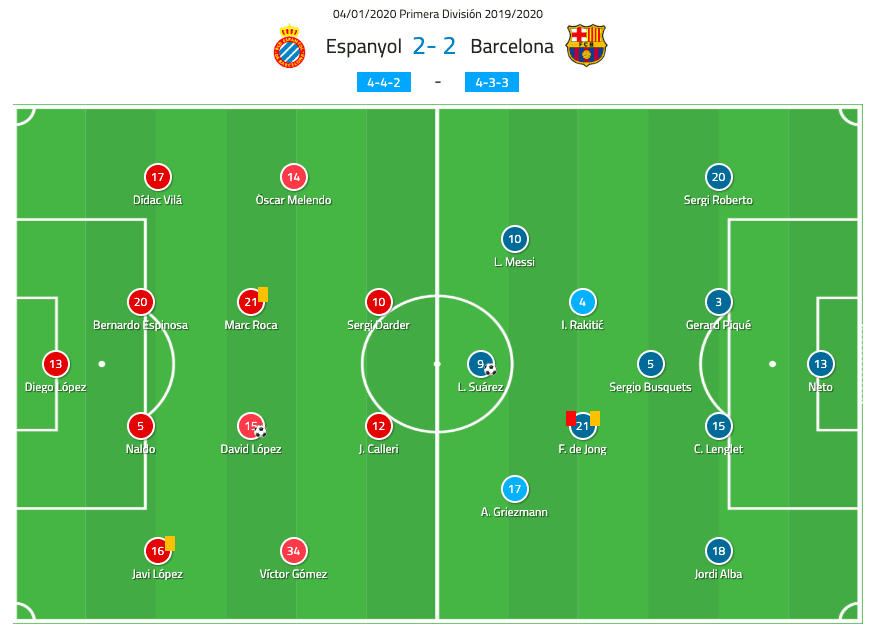
Abelardo set out his Espanyol side in a 4-4-2. Veteran keeper Diego López got the start in goal with Dídac Vilá, Bernardo Espinosa, Naldo and Javi López. The midfield included Óscar Melendo, Marc Roca, David López and Víctor Gómez while Sergi Darder and Jonathan Calleri started up top. Matías Vargas replaced Gómez in the 62nd minute, Ander Iturraspe came on for goal-scorer David López, and Wu Lei subbed on for Melendo.
For Ernesto Valverde’s 4-3-3, Neto started in goal with Marc-André ter Stegen still sidelined. All the usual suspects started on Barcelona’s backline, as Sergi Roberto, Gerard Piqué, Clément Lenglet and Jordi Alba received the starts. In front of them were Sergio Busquets, de Jong and Ivan Rakitic. Up top were Lionel Messi, Luis Suárez and Antoine Griezmann.
Espanyol’s defensive shape
This was a tight affair in the early stages of the game. Most of the first half was played in the middle third of the field as Barcelona attempted to break the wall of Espanyol defenders. Abelardo’s side was very compact and organized. Espanyol’s 4-4-2 was standard, but the energy, focus and communication they employed were spectacular. The backline was especially vocal, using their voices and hands to direct teammates. While they preferred to defend in a middle block, as Barcelona progressed higher up the field, the priority was getting numbers behind the ball.
Espanyol’s disciplined approach paid dividends in the early going. Barcelona tried to play centrally through Busquets, de Jong and Rakitic, but the Espanyol midfield swarmed to the ball. Barcelona’s first shot of the game didn’t come until 26 minutes had elapsed, but Messi’s soft attempt was easily gathered by Diego López. The next Barcelona shot didn’t come until the 41st minute. Overall, a brilliant first 40 minutes from Espanyol saw them take the lead on their lone first-half attempt.
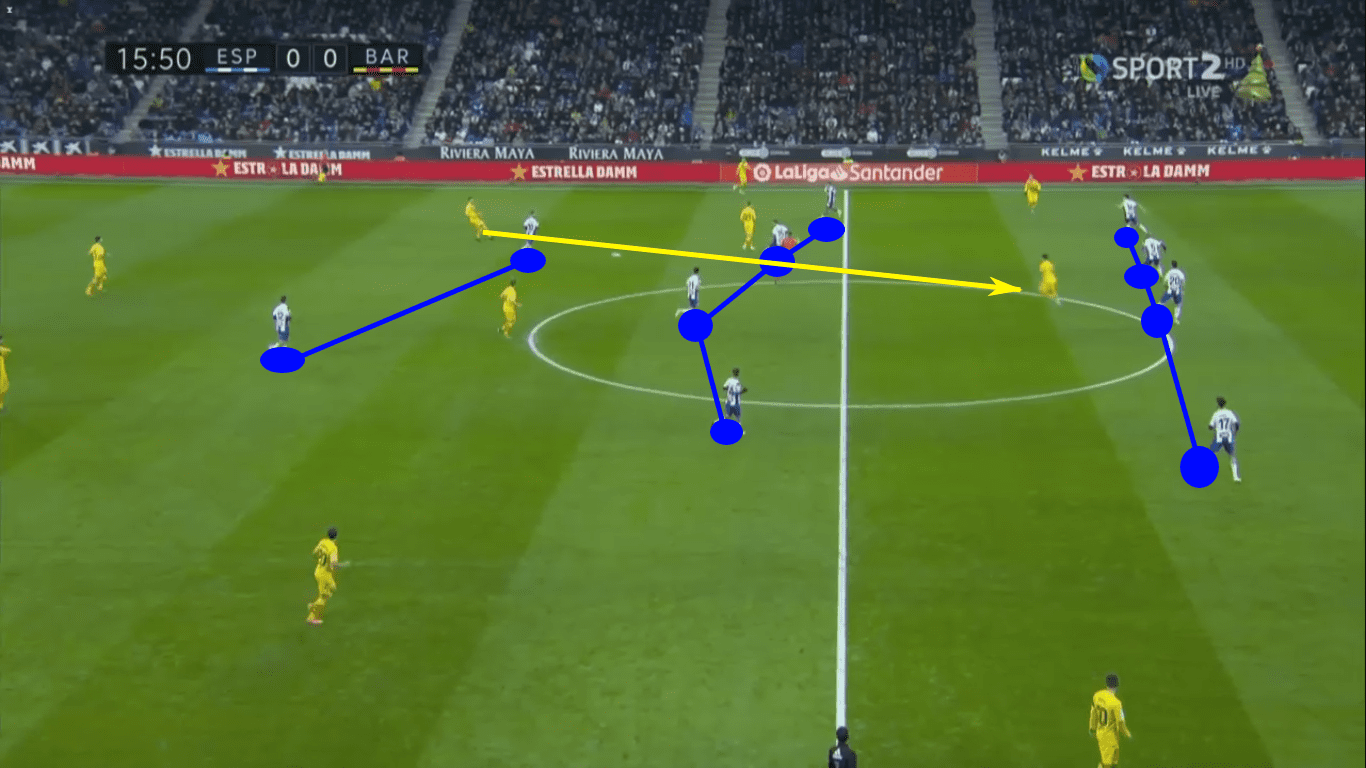
Espanyol’s attention to defensive details was evident early on. In this instance, Espanyol set up the two banks of four and used the two forwards to funnel play wide and prevent switches of play through the backline. As you can see in the above image, Espanyol has taken away the short-range options, forcing Lenglet to either play to his keeper or attempt a risky, line-breaking pass. He opted for the latter, playing into the checking run of Suárez.
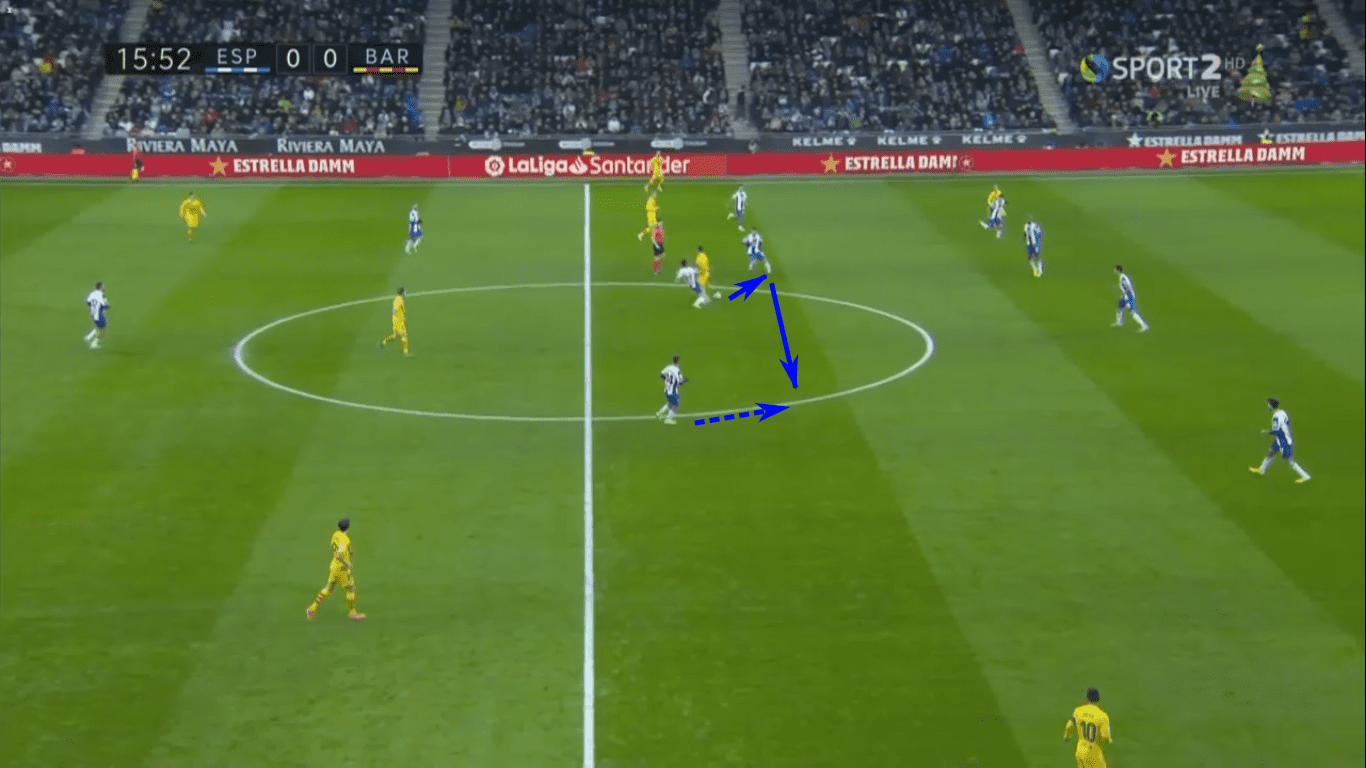
The backline held its ground, preventing the emergence of gaps, while the midfield quickly closed down on Suárez. Marc Roca rushed in to put in the tackle, making contact and poking the ball to David López.
Minutes 40 to 65 were another story. Messi dropped deeper into the midfield, playing between Espanyol’s midfield and defensive lines. From that part of the field, he was able to focus on attention on creating opportunities for his teammates while also getting some touches on the ball. With Messi dropping into the midfield, Vidal played high up the pitch in the second half to make his trademark runs into the box. Griezmann also did well to stretch the field vertically, opening up space for Suárez to run into the box. During that 25 minute stretch, Barcelona took 10 shots, scoring on two of them.
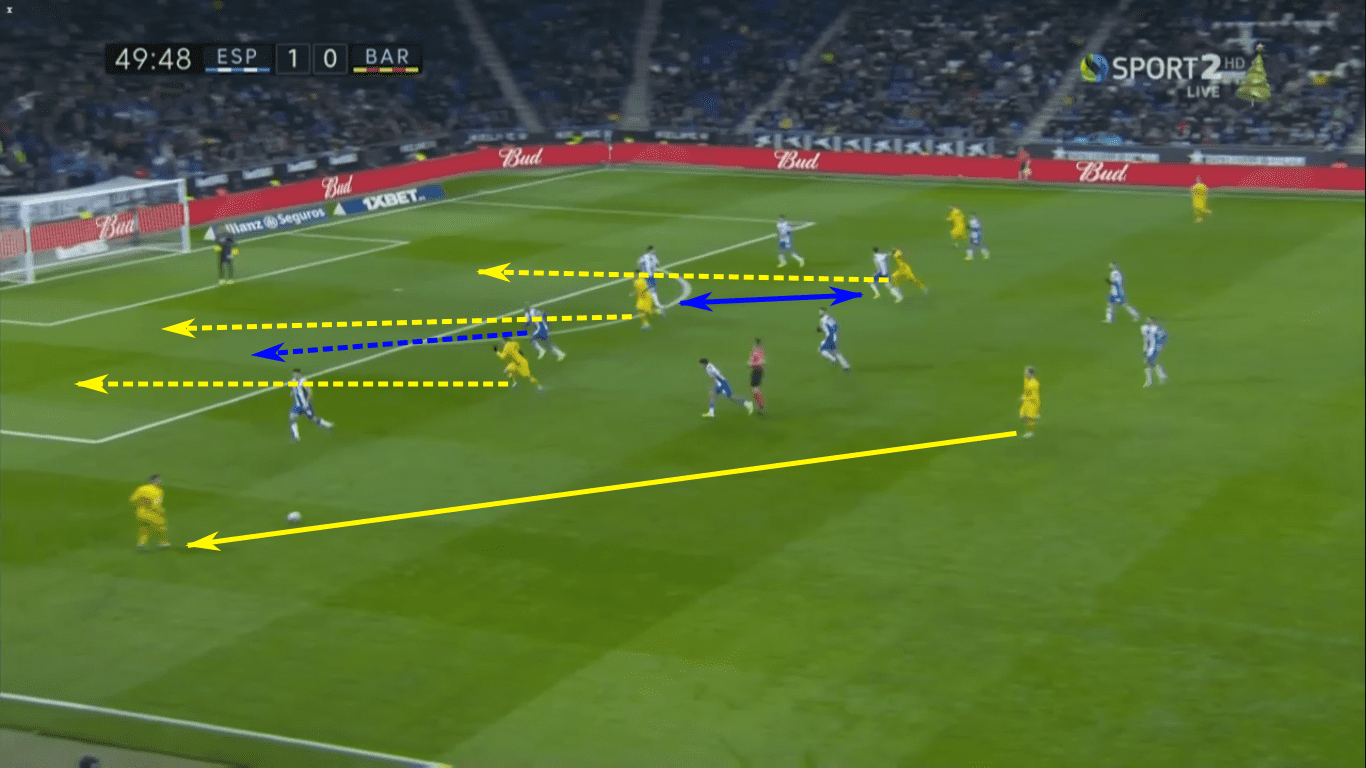
From the 40th minute on, Barcelona had more success breaking down the Espanyol defence. Here de Jong played the wide run of Abla. Griezmann’s run into the wide area of the half-space attracted the attention of Naldo, but Suárez ran untracked to the near-post. Bernardo was singularly focused on picking up the run of Vidal, failing to recognize Barcelona’s numerical superiority on the left.
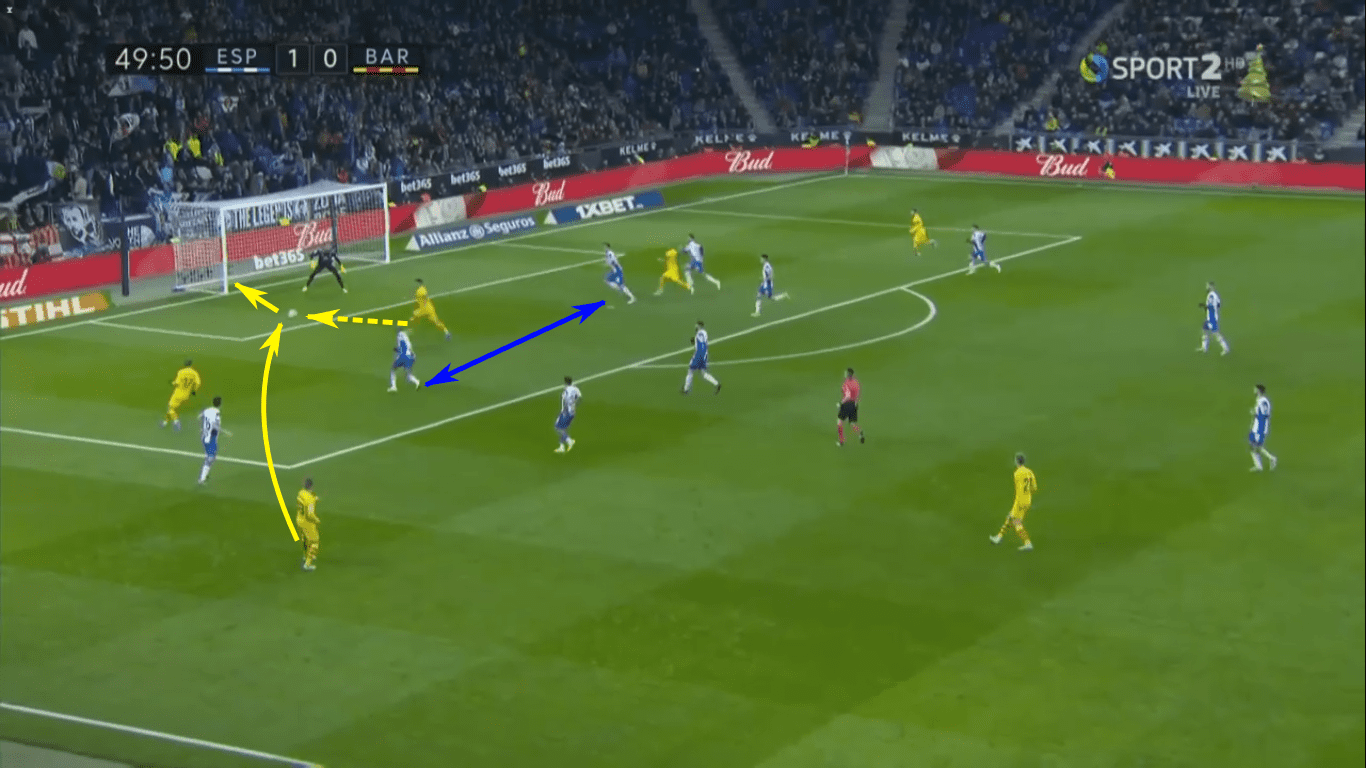
With no one tracking his run, Suárez ran onto the near-post cross of Alba, finishing at the near-post. Look at the gap between Naldo and Bernardo. Once the cross is sent, Naldo awkwardly paused in No Man’s Land when he knew Bernardo didn’t cover him and Bernardo ran to the near-post in the hope of Suárez scuffling the shot. Just like that, an Espanyol mistake resulted in a goal.
Emphasis on dribbling
A typical La Liga game will see each team attempt around 20 to 25 dribbles per game. If one of those teams is Real Madrid or Barcelona, 30 attempts is relatively reasonable. Barcelona averages 27.6 dribbles per game. With the wealth of individual talent at those clubs, 1v1 isolation or overloads create a significant qualitative advantage.
In this game, Barcelona attempted a staggering 44 dribbles, beating its opponents on 21 occasions. That equates to a 48% success rate. Messi led the way with 18 dribble attempts but only succeeded in 7 cases, good for 39%. Only de Jong’s two for six night was worse. Suares attempted 9 and completed 4 (44%) while all the other Barcelona players, minus Piqué, achieved either a 50% or 100% success rate.
Espanyol entered the game averaging 21.3 dribbling attempts per game and a 42% success rate. In this game, they attempted 25 and completed 12, resulting in a 48% success rate. Given Barcelona’s narrow playing shape, Espanyol focused its attacks on the wings, taking advantage of open space and 1v1s. Of the 14 Espanyol players to see the field, only seven attempted dribbles, which reflects its desire to play safely at the back and be selective in the attack. Despite a poor overall game, Calleri won four of his eight dribbles, including 2/2 against Lenglet. Javi López had a strong performance, winning three of his five dribbles.
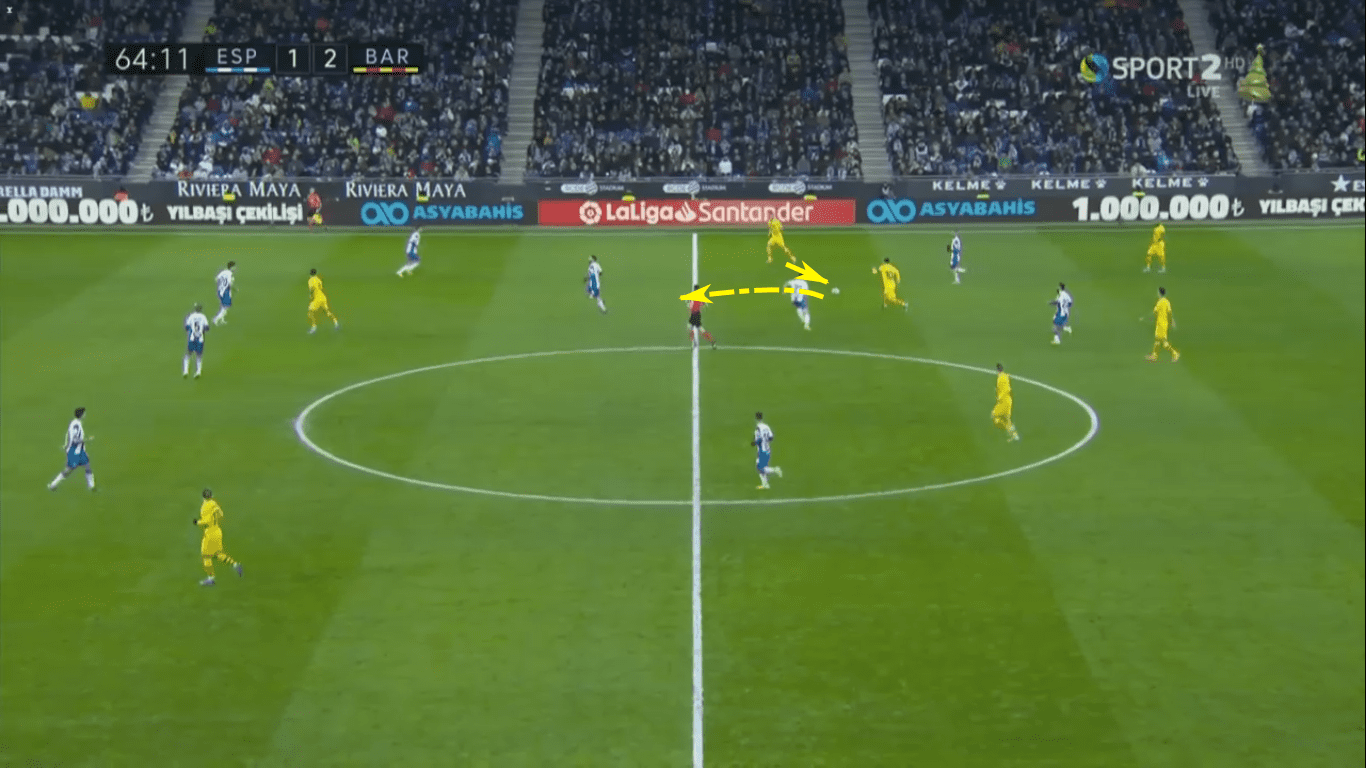
This run by Messi is simply too good not to feature. Seeing the opponent behind Messi, Sergi Roberto played a soft pass to the Argentinian. Messi ran forward to collect the ball and cut around Roca.
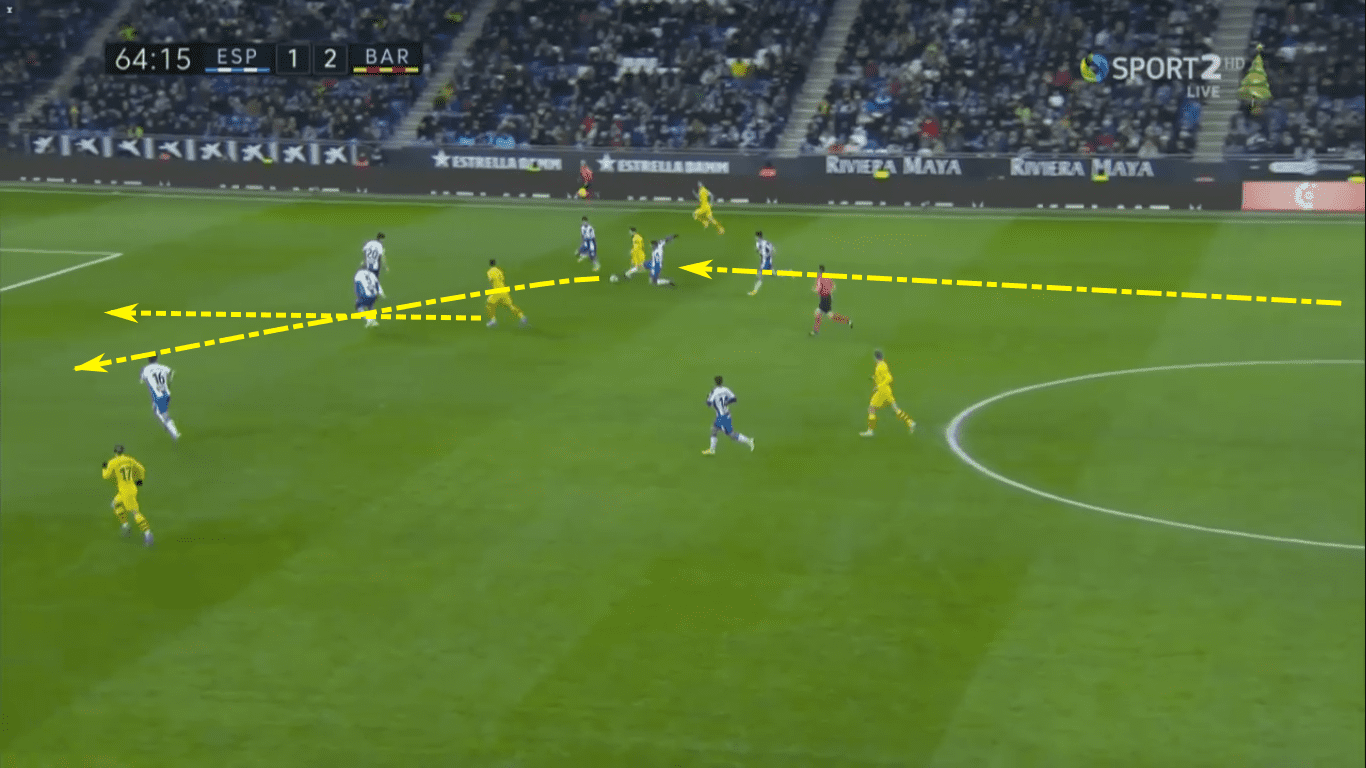
David López missed on the sliding tackle and Vilá bounced off of Messi, leaving a path to the middle. As Messi dribbled to the inside, Suárez made a vertical run to stretch the defence, clearing space for Messi to continue his path with minimal opposition.
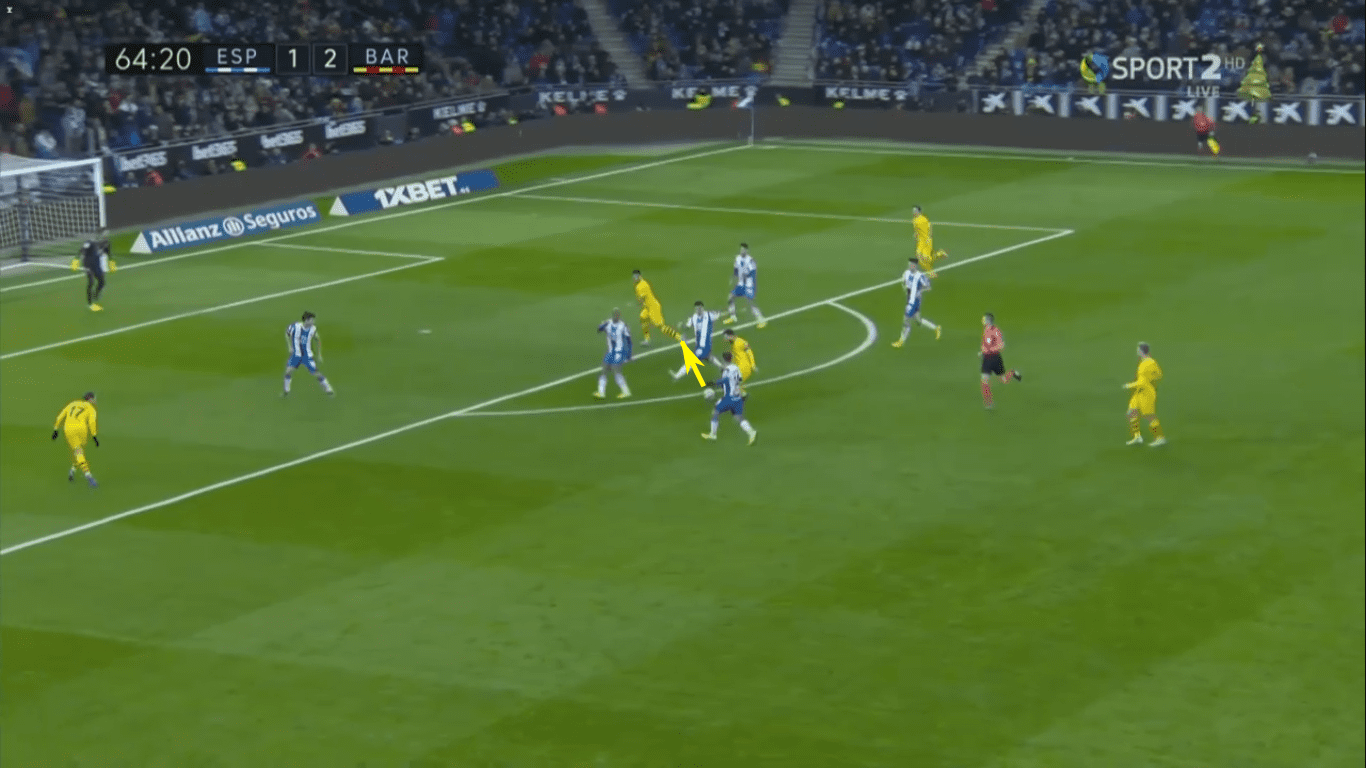
Bernardo stepped up but was too slow to stop Messi, forcing Naldo to take a few steps forward. As Naldo moved forward in coverage, Messi nutmegged Bernardo, playing Suárez in on goal. His left-footed shot had an xG of 0.31, but Diego López made a nice reflex save to keep Espanyol within a goal.
Instant Impact of Substitutes
Abelardo and Valverde made excellent use of their substitutes. For Valverde, bringing Vidal on for Rakitic at the half was a bold call, but it paid dividends right away. Vidal was a major presence in the midfield, engaging in 51 actions, 44 were successful (86%). His 94% pass rate and eight wins in 12 duels (67%) played a major role in Barcelona’s second-half success. Most importantly, he scored the second goal, giving his side a temporary lead.
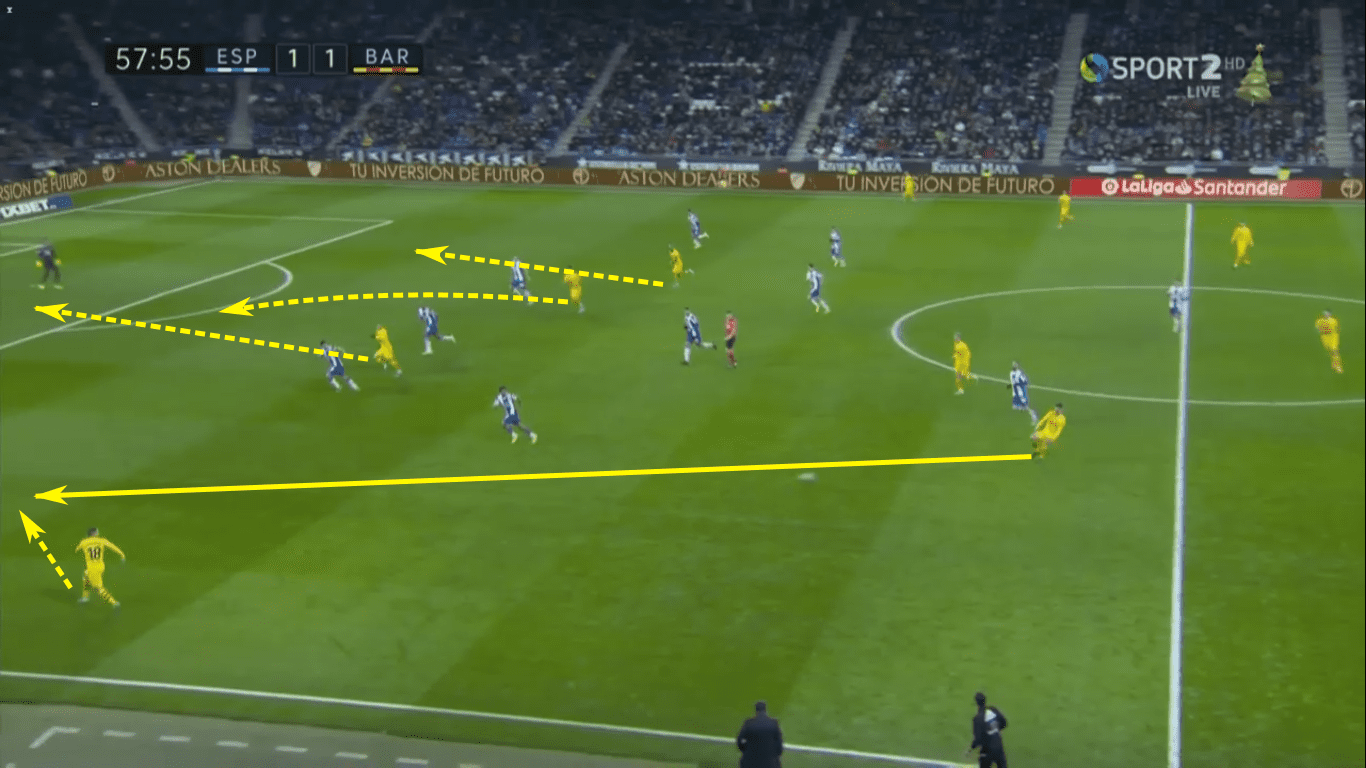
Here Lenglet played the run of Alba. The outside-back had a great run of play between the 40th and 70th minutes, frequently taking advantage of open space on the wing. As Alba prepared to cross, Griezmann, Suárez and Vidal made their runs into the box. Much like the first goal, Suárez allowed Griezmann to go first and take a higher position, then the Uruguayan ran into the vacated space.
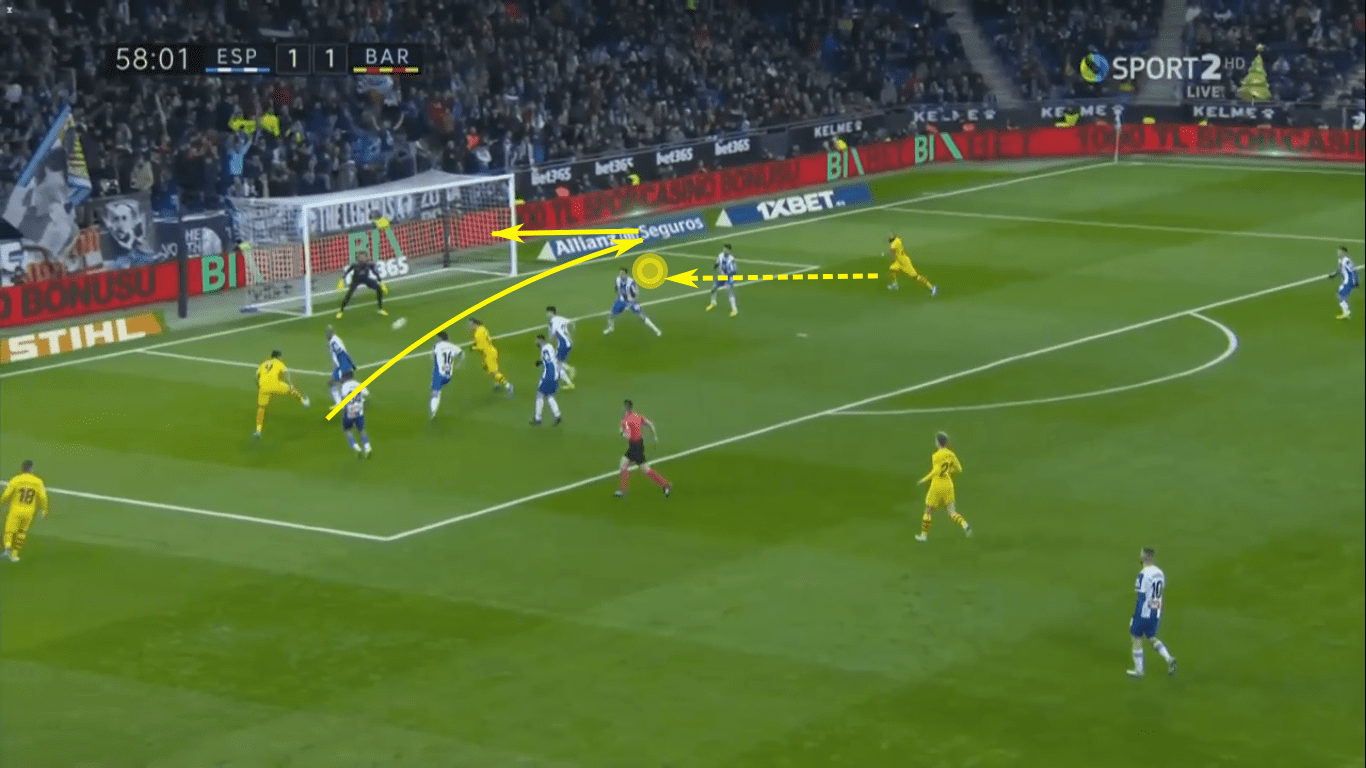
Alba’s cross was poor, but it was also poorly handled. A few ricochets later, Suárez was able to poke the ball away from an opponent and hit a delightful trivela onto the head of Vidal. The Chilean smashed it off the hands of David López and into the back of the net. Of his six goals this season, Vidal has three game-winning goals, one game-tying goal. If Barcelona does sell him, as is rumoured, they’ll surely miss his production, energy and super-sub performances.
Lei and Vargas were the two big subs for Espanyol. The Chinese was a livewire up top, constantly making runs behind the Barcelona backline. Lenglet had his hands full tracking Lei’s runs. Despite playing only 20 minutes, Lei was able to take three shots, all on target, and collect the game-tying goal. Vargas provided the assist on the goal. Though he and his teammates didn’t experience a lot of attacking joy in the game, Vargas managed to provide one of Espanyol’s two key passes. In a game like this one, with Espanyol directing most of its energy and attention to defending, attacking movements needed to be decisive. Vargas was just that.
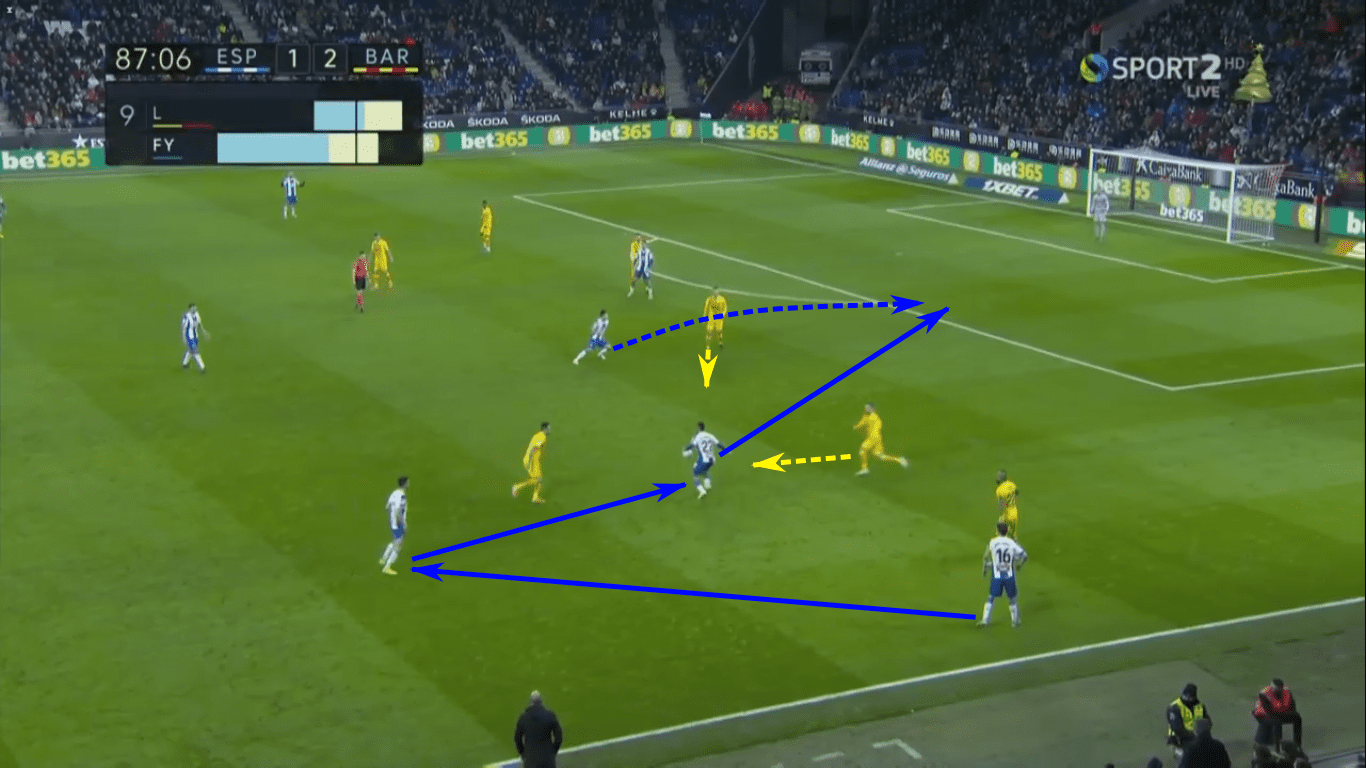
Here we saw Javi López play a negative pass to Roca. With Vargas asking for the ball just in front of Alba, the Spaniard moved forward to pressure. Lenglet saw Alba move forward, which caused him to move a few steps closer in coverage. However, as that happened, Lei ran behind the Frenchman, leaving him no chance of defending the play.
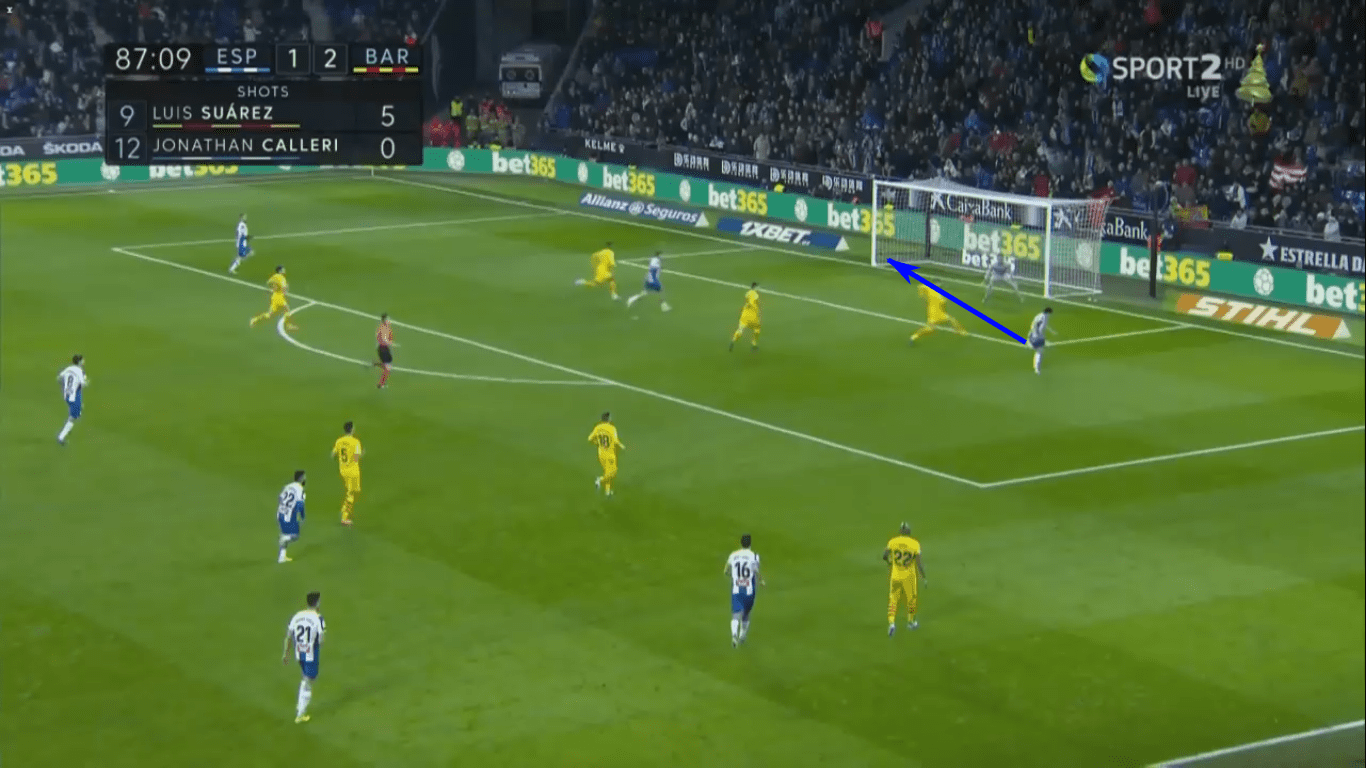
Pique couldn’t cover in time and Lie perfectly hit his shot just inside the post, scoring the tying goal on a 0.08 xG finish. Abelardo’s subs picked up the goal and assist in this well-crafted play.
Conclusion
The draw left Barcelona tied with Real Madrid on points, leading the capitol side on goal differential. It’s a disappointing result for Valverde’s men, leaving them with one win in their last four league games. After de Jong’s red card, Barcelona conceded five shots, failing to see out the result. A Super Cup semi-final tie against Atlético Madrid awaits them on Thursday.
Abelardo’s couldn’t have started much better, securing an important point against the league leaders. He’ll surely be pleased with his side’s mindset. If they can correct a few of the issues at the back, safety is well within their reach. Though he’s new to the team, he’s become a relegation saviour in Spain. Be sure to check Total Football Analysis this Saturday for an in-depth analysis of the new Espanyol coach. We’ll take a look at how Abelardo’s teams have played in the past and what changes you can expect at the RCDE Stadium.





Comments